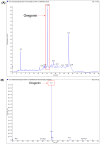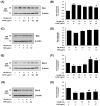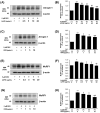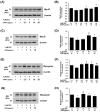Effects of Alnus japonica Hot Water Extract and Oregonin on Muscle Loss and Muscle Atrophy in C2C12 Murine Skeletal Muscle Cells
- PMID: 39770504
- PMCID: PMC11676106
- DOI: 10.3390/ph17121661
Effects of Alnus japonica Hot Water Extract and Oregonin on Muscle Loss and Muscle Atrophy in C2C12 Murine Skeletal Muscle Cells
Abstract
Background/Objectives: Sarcopenia is characterized by the loss of muscle mass and function, increases in mortality rate, and risk of comorbidities in the elderly. This study evaluated the effects of Alnus japonica hot water extract (AJHW) and its active compound, oregonin, on muscle atrophy and apoptosis in vitro. Methods: AJHW underwent phytochemical analysis. C2C12 cells were subjected to H2O2 and dexamethasone to induce oxidative stress and muscle loss, after which AJHW and oregonin were administered to assess their impacts on cell viability, apoptosis, muscle protein synthesis stimulation, and muscle protein degradation inhibition. Cell viability was assessed via an MTT assay, and apoptosis was analyzed by measuring Bcl-2, Bax, cleaved caspase-3, and cleaved PARP through Western blotting. Western blotting and RT-PCR were utilized to analyze MyoD, Myogenin, Atrogin-1, and MuRF1 protein and gene expression in a muscle atrophy model, as well as the Akt/mTOR and FoxO3α pathways. Results: AJHW was confirmed to contain oregonin, an active compound. AJHW and oregonin significantly increased cell viability and reduced apoptosis by upregulating Bcl-2 and downregulating Bax, cleaved caspase-3, and cleaved PARP. They significantly enhanced muscle protein synthesis through the upregulation of MyoD and Myogenin, while diminishing muscle degradation by downregulating Atrogin-1 and MuRF1. The activation of the Akt/mTOR pathway and inhibition of the FoxO3α pathway were also observed. Conclusions: AJHW and oregonin effectively prevented muscle cell apoptosis, promoted muscle protein synthesis, and inhibited muscle protein degradation in vitro. These results suggest that AJHW and oregonin could serve as therapeutic agents to prevent and treat sarcopenia.
Keywords: Alnus japonica; apoptosis; hot water extract; muscle atrophy; oregonin; sarcopenia.
Conflict of interest statement
The corresponding author declares filing patents related to the use of oregonin from
Figures



















Similar articles
-
Effects of Alnus japonica Pilot Scale Hot Water Extracts on a Model of Dexamethasone-Induced Muscle Loss and Muscle Atrophy in C57BL/6 Mice.Int J Mol Sci. 2025 Apr 12;26(8):3656. doi: 10.3390/ijms26083656. Int J Mol Sci. 2025. PMID: 40332160 Free PMC article.
-
Vigeo Promotes Myotube Differentiation and Protects Dexamethasone-Induced Skeletal Muscle Atrophy via Regulating the Protein Degradation, AKT/mTOR, and AMPK/Sirt-1/PGC1α Signaling Pathway In Vitro and In Vivo.Nutrients. 2024 Aug 13;16(16):2687. doi: 10.3390/nu16162687. Nutrients. 2024. PMID: 39203823 Free PMC article.
-
Effects of Ulmus macrocarpa Extract and Catechin 7-O-β-D-apiofuranoside on Muscle Loss and Muscle Atrophy in C2C12 Murine Skeletal Muscle Cells.Curr Issues Mol Biol. 2024 Aug 1;46(8):8320-8339. doi: 10.3390/cimb46080491. Curr Issues Mol Biol. 2024. PMID: 39194708 Free PMC article.
-
Water Extract of Lotus Leaf Alleviates Dexamethasone-Induced Muscle Atrophy via Regulating Protein Metabolism-Related Pathways in Mice.Molecules. 2020 Oct 9;25(20):4592. doi: 10.3390/molecules25204592. Molecules. 2020. PMID: 33050143 Free PMC article.
-
PI3 kinase regulation of skeletal muscle hypertrophy and atrophy.Curr Top Microbiol Immunol. 2010;346:267-78. doi: 10.1007/82_2010_78. Curr Top Microbiol Immunol. 2010. PMID: 20593312 Review.
Cited by
-
Effects of Alnus japonica Pilot Scale Hot Water Extracts on a Model of Dexamethasone-Induced Muscle Loss and Muscle Atrophy in C57BL/6 Mice.Int J Mol Sci. 2025 Apr 12;26(8):3656. doi: 10.3390/ijms26083656. Int J Mol Sci. 2025. PMID: 40332160 Free PMC article.
References
-
- Rhee S.Y. Role of Sarcopenia in Diabetes Mellitus. J. Korean Diabetes. 2013;14:178–182. doi: 10.4093/jkd.2013.14.4.178. - DOI
Grants and funding
LinkOut - more resources
Full Text Sources
Research Materials
Miscellaneous

